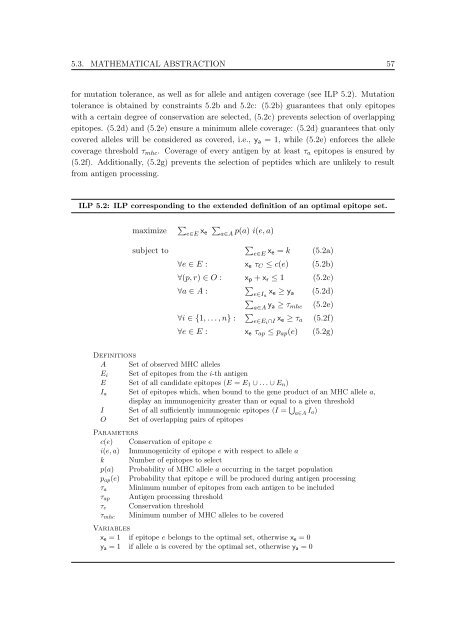New Approaches to in silico Design of Epitope-Based Vaccines
New Approaches to in silico Design of Epitope-Based Vaccines
New Approaches to in silico Design of Epitope-Based Vaccines
You also want an ePaper? Increase the reach of your titles
YUMPU automatically turns print PDFs into web optimized ePapers that Google loves.
5.3. MATHEMATICAL ABSTRACTION 57<br />
for mutation <strong>to</strong>lerance, as well as for allele and antigen coverage (see ILP 5.2). Mutation<br />
<strong>to</strong>lerance is obta<strong>in</strong>ed by constra<strong>in</strong>ts 5.2b and 5.2c: (5.2b) guarantees that only epi<strong>to</strong>pes<br />
with a certa<strong>in</strong> degree <strong>of</strong> conservation are selected, (5.2c) prevents selection <strong>of</strong> overlapp<strong>in</strong>g<br />
epi<strong>to</strong>pes. (5.2d) and (5.2e) ensure a m<strong>in</strong>imum allele coverage: (5.2d) guarantees that only<br />
covered alleles will be considered as covered, i.e., ya = 1, while (5.2e) enforces the allele<br />
coverage threshold τmhc. Coverage <strong>of</strong> every antigen by at least τa epi<strong>to</strong>pes is ensured by<br />
(5.2f). Additionally, (5.2g) prevents the selection <strong>of</strong> peptides which are unlikely <strong>to</strong> result<br />
from antigen process<strong>in</strong>g.<br />
ILP 5.2: ILP correspond<strong>in</strong>g <strong>to</strong> the extended def<strong>in</strong>ition <strong>of</strong> an optimal epi<strong>to</strong>pe set.<br />
maximize <br />
e∈E xe<br />
subject <strong>to</strong><br />
<br />
a∈A p(a) i(e, a)<br />
<br />
e∈E xe = k (5.2a)<br />
∀e ∈ E : xe τC ≤ c(e) (5.2b)<br />
∀(p, r) ∈ O : xp + xr ≤ 1 (5.2c)<br />
∀a ∈ A :<br />
<br />
(5.2d)<br />
e∈Ia xe ≥ ya<br />
<br />
a∈A ya<br />
∀i ∈ {1, . . . , n} :<br />
≥ τmhc (5.2e)<br />
<br />
e∈Ei∩I xe ≥ τa (5.2f)<br />
∀e ∈ E : xe τap ≤ pap(e) (5.2g)<br />
Def<strong>in</strong>itions<br />
A Set <strong>of</strong> observed MHC alleles<br />
Ei Set <strong>of</strong> epi<strong>to</strong>pes from the i-th antigen<br />
E Set <strong>of</strong> all candidate epi<strong>to</strong>pes (E = E1 ∪ . . . ∪ En)<br />
Ia Set <strong>of</strong> epi<strong>to</strong>pes which, when bound <strong>to</strong> the gene product <strong>of</strong> an MHC allele a,<br />
display an immunogenicity greater than or equal <strong>to</strong> a given threshold<br />
I Set <strong>of</strong> all sufficiently immunogenic epi<strong>to</strong>pes (I = <br />
a∈A Ia)<br />
O Set <strong>of</strong> overlapp<strong>in</strong>g pairs <strong>of</strong> epi<strong>to</strong>pes<br />
Parameters<br />
c(e) Conservation <strong>of</strong> epi<strong>to</strong>pe e<br />
i(e, a) Immunogenicity <strong>of</strong> epi<strong>to</strong>pe e with respect <strong>to</strong> allele a<br />
k Number <strong>of</strong> epi<strong>to</strong>pes <strong>to</strong> select<br />
p(a) Probability <strong>of</strong> MHC allele a occurr<strong>in</strong>g <strong>in</strong> the target population<br />
pap(e) Probability that epi<strong>to</strong>pe e will be produced dur<strong>in</strong>g antigen process<strong>in</strong>g<br />
τa M<strong>in</strong>imum number <strong>of</strong> epi<strong>to</strong>pes from each antigen <strong>to</strong> be <strong>in</strong>cluded<br />
τap Antigen process<strong>in</strong>g threshold<br />
τc Conservation threshold<br />
M<strong>in</strong>imum number <strong>of</strong> MHC alleles <strong>to</strong> be covered<br />
τmhc<br />
Variables<br />
xe = 1 if epi<strong>to</strong>pe e belongs <strong>to</strong> the optimal set, otherwise xe = 0<br />
ya = 1 if allele a is covered by the optimal set, otherwise ya = 0

















